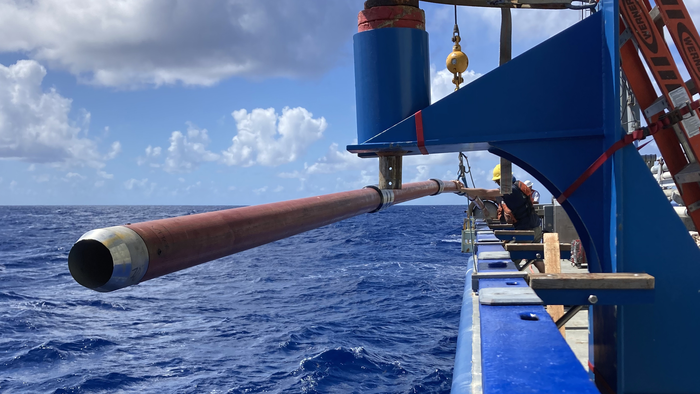Woods Hole, MA (April 21, 2022) – A team of scientists, engineers, and ship’s crew on the research vessel Neil Armstrong operated by the Woods Hole Oceanographic Institution (WHOI) recently collected a 38-foot-long cylindrical sediment sample from the deepest part of the Puerto Rico Trench, nearly 5 miles below the surface. The sample core is breaking records as the deepest ever collected in the Atlantic Ocean, and possibly the deepest core collected in any ocean.

Credit: (Photo by Paul Walczak, Oregon State University)
Woods Hole, MA (April 21, 2022) – A team of scientists, engineers, and ship’s crew on the research vessel Neil Armstrong operated by the Woods Hole Oceanographic Institution (WHOI) recently collected a 38-foot-long cylindrical sediment sample from the deepest part of the Puerto Rico Trench, nearly 5 miles below the surface. The sample core is breaking records as the deepest ever collected in the Atlantic Ocean, and possibly the deepest core collected in any ocean.
The event took place aboard a collaborative cruise in Puerto Rico between February and March, 2022. The group responsible for the core collection was led by Prof. Steven D’Hondt and Dr. Robert Pockalny from the University of Rhode Island’s Graduate School of Oceanography and included researchers and technicians from WHOI, University of Rhode Island, University of California San Diego, Oregon State University, University of Washington, University of Puerto Rico Mayagüez, and University of Munich.
Long sediment cores are generally collected by allowing a core pipe with a lead weight on top to fall through the water and into soft sediment that collects on the seafloor over long periods of time. When the pipe is pulled out of the seafloor and back up to the ship, the recovered sediment inside can be used to study Earth’s environmental conditions and climate dating back tens or hundreds of thousands, or even millions, of years ago.
Scientists are also interested in understanding genetic traits that enable microscopic organisms to survive within seafloor sediments. The main objective of this expedition was to better understand how microbes at different depths below the seafloor have adapted to vastly different environmental conditions present across the entire depth range of the trench. Over the course of three weeks at sea, the team collected cores from a water depth of about 50 meters (165 feet) to the trench’s maximum depth of about 8,385 meters (27,510 feet).
“We took these cores to learn how microbes that live beneath the seafloor respond to pressure,” said D’Hondt. “Our ultimate objective is to improve understanding of how organisms in extreme environments engage in the world around them. “Our team’s success in extracting this core from the deepest part of the Atlantic Ocean will enable us to make a tremendous advance in our understanding of this little-known part of life on Earth.”
The core collections were made possible by the long core system originally developed at WHOI in 2007 by then-research specialist Jim Broda for the research vessel Knorr. After the ship’s retirement, the system was adapted to fit the slightly shorter vessel Neil Armstrong. After this expedition, the long corer will be transferred to the OSU Marine Sediment Sampling Group, which is funded by the U.S. National Science Foundation and supports coring operations throughout the U.S. academic research fleet, so it can be made available to the entire oceanographic community.
“This achievement was only possible thanks to phenomenal teamwork by everyone involved, including those who helped develop the long corer nearly 20 years ago,” said Rick Murray, WHOI Deputy Director and Vice President of Science and Engineering. “The fact that the long corer will move to the capable hands of our friends and colleagues at Oregon State University means it will have many more years of use by the ocean science community to help advance knowledge about our planet.”
###
About Woods Hole Oceanographic Institution
The Woods Hole Oceanographic Institution (WHOI) is a private, non-profit organization on Cape Cod, Massachusetts, dedicated to marine research, engineering, and higher education. Established in 1930, its primary mission is to understand the ocean and its interaction with the Earth as a whole, and to communicate an understanding of the ocean’s role in the changing global environment. WHOI’s pioneering discoveries stem from an ideal combination of science and engineering—one that has made it one of the most trusted and technically advanced leaders in basic and applied ocean research and exploration anywhere. WHOI is known for its multidisciplinary approach, superior ship operations, and unparalleled deep-sea robotics capabilities. We play a leading role in ocean observation and operate the most extensive suite of data-gathering platforms in the world. Top scientists, engineers, and students collaborate on more than 800 concurrent projects worldwide—both above and below the waves—pushing the boundaries of knowledge and possibility. For more information, please visit www.whoi.edu.




